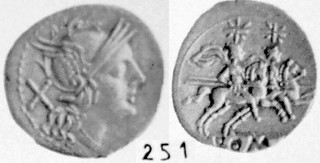Pics below. At least I think they are interesting. Here is why:
1. bird and TOD - unusually the bird on this coin looks like a raven not a wren. Compare my existing example which is very wren-like:

2.
anchor semis, this the very
rare Cr.194 not the merely
scarce Cr.50
3. C
denarius from
Etruria, the
type always in crude
style and this especially so, but with no die breaks which are common on these
types4. from
collection Fenelon Farez (1793-1862), a key leader in the 1848
French revolutionary movement. This piece has been presumed a
fake for a long time as though it looks struck there are depressions behind the
head that might be casting defects, or
flan defects, or corrosion defects or
overstrike defects, and a couple of experts have presumed it to be
cast due to these defects. The only other example of this
type is the ex-RBW coin here, from different dies:
http://www.acsearch.info/search.html?id=1102976 Personally I believe it probably genuine as the
style is absolutely correct for the era and I very much doubt an early 19th century forger could have made such a piece. A corroborating fact is that the piece is on a conical
flan that is typical of this era and that to me seems a step to far in forger's ingenuity. The reverses absolutely looks struck. Hence I presume the defects to be
flan defects, corrosion defects or
overstrike defects and the coin to be genuine. Highly desirable as such
5. Just a nice EF uncial
6. acorn-acorn
semuncia, one very rarely sees this with the
denomination mark Sigma fully legible both sides
7. very high relief
wreath as, much better in hand than pic
8. an EF
semis, late first century BC.
9.
VAR denarius. Unusually one sees the
reverse circle was
engraved before the
type was
engraved within and the
type spills over the
circle10. C. Antius
Restio sestertius,
bucranium (
bull's
head)
altar. But this is on a rather larger than usual
flan and weighs 1.87 grams. Undoubtedly ancient and genuine, somewhat flat struck. Is it possible that a
quinarius of the same
type as the
sestertius was struck? Compare the RBW coin, one sees that the bulls
head is significantly larger:
http://www.acsearch.info/search.html?id=127497111.
Carisia quinarius. Just nice even wear. Notable that for both the
Antia sestertius (if that is what it is) and the
Carisia quinarius, there is just a single example of each on
acsearch. Pretty
rare pieces
12. extremely
rare and not properly in
RRC, Cr.113 official
quadrans with
star before the prow, weighing 6.9 grams. Richard Schaefer and I published this
type in NC 2011, and demonstrated that all the quadrantes with
star before the prow and that weigh 3 to 4 grams are in fact unofficial imitations. So, those collectors of only official
Roman coins should discard all their lightweight and incorrect styled "Cr.196/4" quadrantes as being unofficial and
search for the official 7 gram
type in this specific
style. But expect to spend a long time searching...
13. just a pretty well struck Cr.44
quinarius14. Cr.445 Lentulus and Marcellus. Just nice even wear and well centred for a
rare type15. This is an
incuse legend denarius that to me seems like the Bastianelli variant Cr.68 corn-ear
type. The Bastianelli
type was considered unique and I illustrate it here.

This is from a different die pair and if it is unrelated to the Bastianelli
type it is then absolutely unique: the experts in this
area (Debernardi, Schaefer) have never seen another example of this
type or
style.
16. A high relief
fine style near EF
sextans of the second Punic war
overstrike type, which generally come ugly, but this a very pretty coin.
Interesting group...





